Where does steak come from? It’s a question that has been asked for centuries and still doesn’t have a definitive answer. Steak is one of the most popular dishes in the world, and it can be found on dinner tables everywhere. But where do all these steaks come from? To understand this, we must look at the history of steak and its various origins across the globe.
What is Steak?
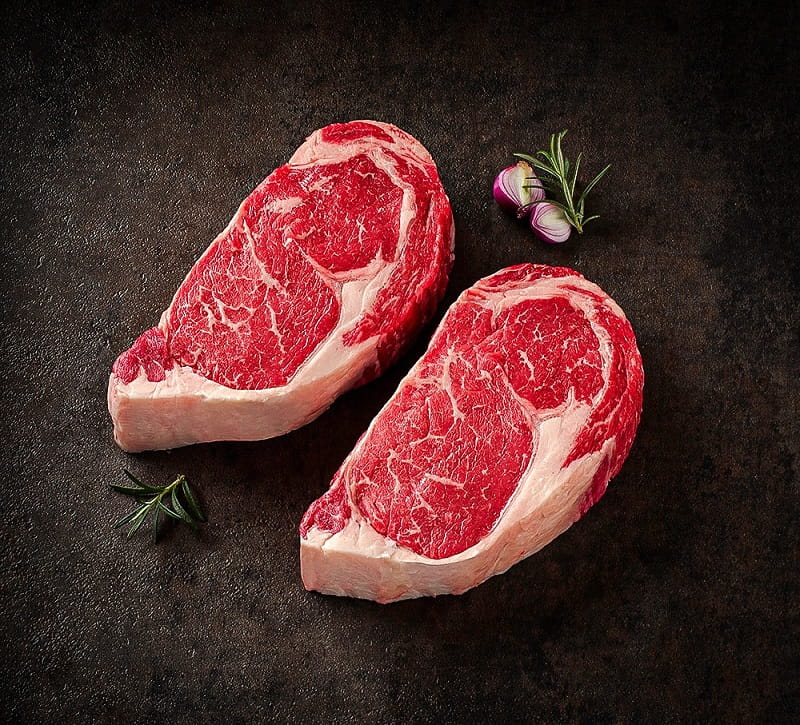
Steak is a delicious, savory type of meat that has been a staple in many cultures for centuries. It is usually cut from the muscle of large land animals, such as cows, pigs, and deer, and is often grilled or pan-fried.
The term “steak” is derived from the Old Norse word “steik,” which means “to roast meat on an open fire.” Many cultures still use this cooking method today, and it is often called “barbecuing.”
There are many different types of steak, each with a unique flavor and texture. When choosing a steak, it’s essential to know the grade of the meat. The USDA grades all steak into four categories: prime, choice, select, and standard. Prime steaks are usually the most tender and flavorful, while standard steaks are often less expensive.
When cooking steak, it’s important to remember that the best results will be achieved when using high-quality ingredients and cooking techniques. It’s also important to let the steak rest for several minutes after cooking so the juices can be reabsorbed into the meat.
Where Does Steak Come From?
Steak is a cut of meat taken from the fleshy parts of a cow, but it can also come from other animals, such as pigs, sheep, and goats. In the United States, steak cut from cattle is known as ‘beefsteak.’ Steaks can be cut from different cow sections, such as the loin and rib sections. T-bone steaks are a popular cut taken from the loin section.
Italy is considered the birthplace of steak as we know it today. Different cuts of steak vary in texture and flavor depending on where they are sourced from and how they are prepared for cooking.
Here is the detail:
Ribeye Steak (AKA scotch fillet)
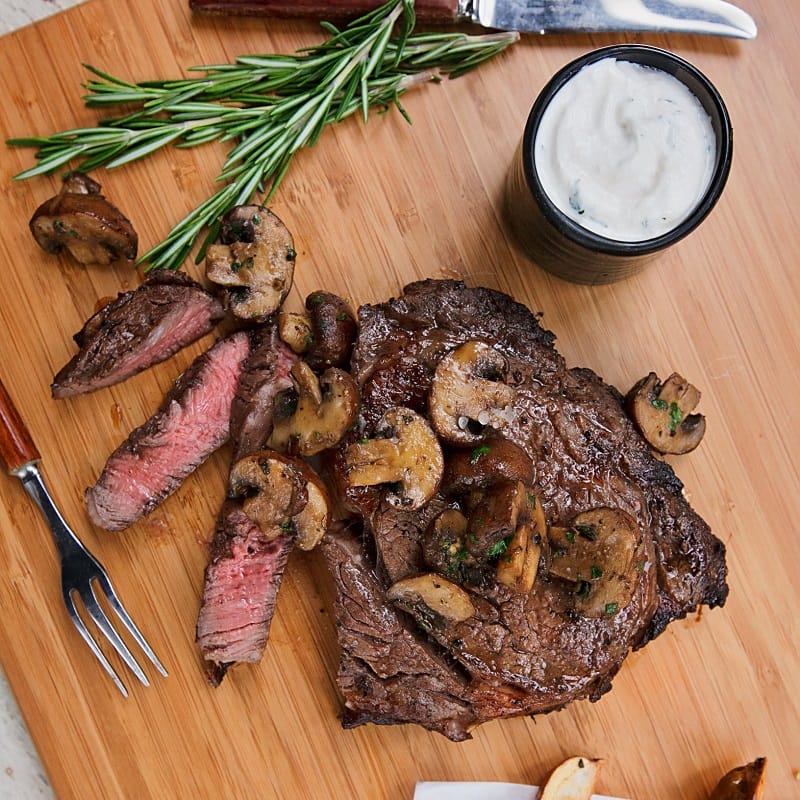
This steak is cut from the rib section of the animal and is one of the most popular cuts of steak. It is often known as a scotch fillet because of its unique shape, which resembles a Scotch whisky bottle. The ribeye steak is a tender and juicy cut of meat with plenty of marbling (fat) throughout.
Sirloin
Sirloin steak is cut from the animal’s rear, near the hip. It is a less tender cut of steak and is usually best served medium-rare or rare. The advantage of the sirloin steak is that it is usually one of the least expensive steaks on the market.
T-Bone
The T-bone steak is cut from the short loin section of the animal. It is one of the most popular steaks and is usually served medium-rare or rare. The T-bone steak is large and contains both the strip steak and the tenderloin.
Hanger Steak
The hanger steak is cut from the diaphragm of the animal. It is a very tender cut of steak and one of the most flavorful. The hanger steak is best-served medium-rare or rare and is often considered gourmet.
Rump Steak
This cut comes from the large, muscular area at the back of a cow, near the tail. Rump steaks are known for their robust flavor and tenderness, making them a popular choice for grilling and pan-frying.
Onglet Steaks
This cut is taken from the diaphragm muscle beneath the rib eye. It has a deep, rich flavor and is incredibly tender when cooked correctly.
Strip Steak
The strip steak is cut from the short loin located on the cow’s back. It is well-marbled, making it juicy and packed with flavor.
Flank Steaks
This cut is taken from the cow’s abdominal muscles near the animal’s rear. It has a chewy texture and intense flavor, making it perfect for marinating before grilling or pan-frying.
Tomahawk
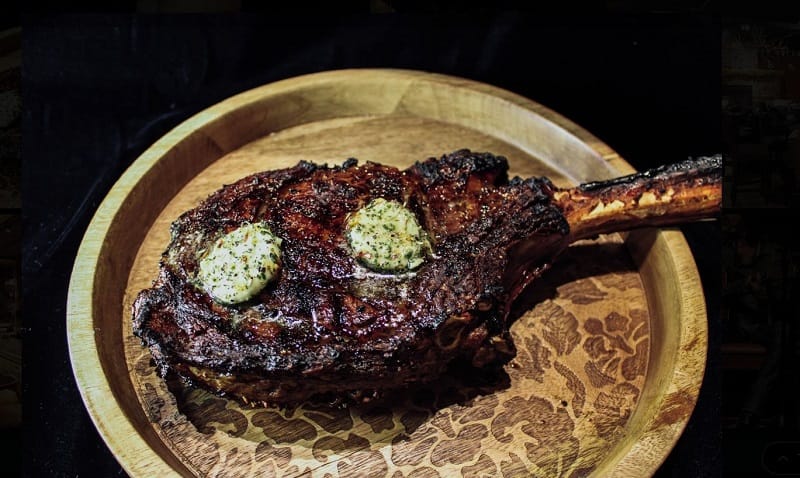
This cut is cut from the rib section and has a long, bone-in rib eye with the rib bone still attached. The tomahawk steak is incredibly flavorful and tender and great for grilling.
Flat-iron Steaks
Flat-iron steaks come from the chuck, or shoulder, of the cow. The chuck is a well-used muscle that makes for a flavorful yet tough cut of steak. Flat-iron steaks are relatively thin, making them ideal for grilling or pan-searing.
Top Round
Top round steaks come from the round, or hindquarters, of the cow. This cut of steak is leaner and tougher than other cuts, making them ideal for slow cooking or braising. Top-round steaks are typically cut thin, perfect for sandwiches, fajitas, and stir-fries.
Porterhouse
Porterhouse steaks come from the short loin located near the cow’s hip. This cut of steak is known for its size and superior flavor, making it ideal for grilling or pan-searing. Porterhouse steaks are typically thick-cut and contain both the tenderloin and the strip steak.
Skirt Steaks
Skirt steaks come from the plate or the belly of the cow. This cut of steak is known for its intense beefy flavor and ability to stay tender after long cooking. Skirt steaks are typically thin-cut, making them perfect for grilling or stir-frying.
Filet Mignon
Filet mignon comes from the tenderloin, located near the cow’s backbone. This cut of steak is known for its superior tenderness and superior flavor. Filet mignon is typically thick-cut, making it ideal for grilling or pan-searing.
See more:
What Are Some Of The Most Popular Cuts For Steak?
If you’re a steak lover, you know there are many different cuts to choose from. Each cut offers unique flavor and texture, from the tenderloin to the sirloin. But with so many different cuts, which ones are the most popular?
Let’s look at some of the most popular cuts of steak and why they’re so beloved.
- Tenderloin: A classic cut of steak, tenderloin is one of the most popular and prized cuts available. This cut is known for its buttery texture and tenderness and is an excellent option for those who don’t like the chewiness of other cuts. The tenderloin is great for steak sandwiches, salads, and steaks cooked with light seasonings.
- Ribeye: This steak is known for its bold flavor and generous marbling and fat content. Ribeye is a great cut for those who prefer their steak on the rare side, as it offers plenty of juicy flavors.
- Strip Steak: Also known as New York Strip or Kansas City Strip, this cut offers a great balance of tenderness and flavor. Strip steaks are especially popular in restaurants, as they offer a great combination of flavor and texture.
- Flank Steak: Flank steak is a lean cut of beef that is great for those looking for a steak without too much fat. This cut offers a great flavor and plenty of tenderness, making it a great choice for those who don’t want to skimp on taste.
- Filet Mignon: Another classic cut, this steak is one of the most tender and luxurious cuts of beef. Known for its melt-in-your-mouth texture, filet mignon is a great choice for steak lovers who want to indulge in a decadent dining experience.
What is the Difference Between Steak and Pork Chops?
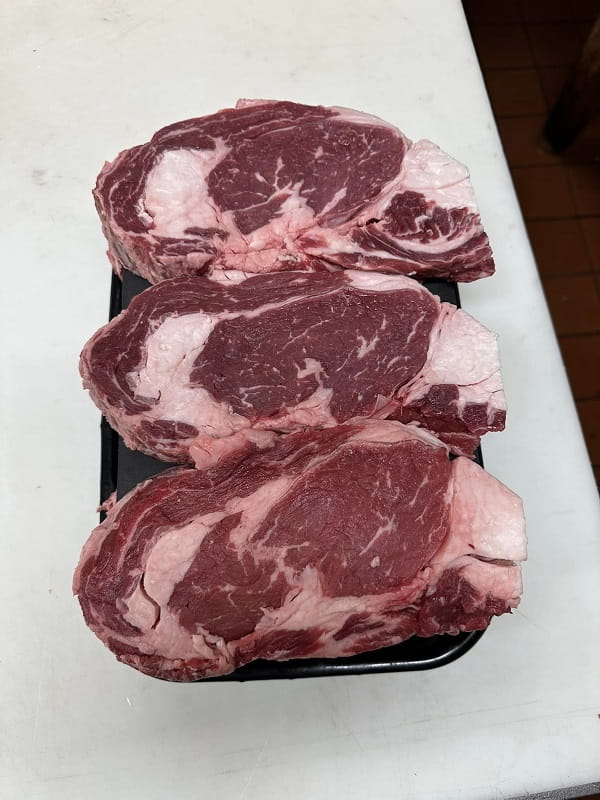
When it comes to deciding between steak and pork chops for dinner, it can be a difficult decision. Both meats have distinct flavors and textures, and there are also a few differences between them. So, what are the differences between steak and pork chops?
- First, steak is often cut from a cow, while pork chops are usually cut from a pig. This is an important distinction, as the flavor and texture of the two different meats will be very different. Steak is often cut from the loin, the most tender part of the animal, while pork chops are typically cut from the shoulder, which is a much tougher cut. As a result, steak is generally more tender and juicy than pork chops, while pork chops tend to be a bit tougher and chewier.
- When it comes to flavor, steak is usually slightly more flavorful than pork chops, as it has a bit of a beefy flavor. On the other hand, pork chops have a milder flavor, as they are less fatty than steak. Additionally, steak is usually seasoned with salt and pepper before cooking, while pork chops are typically left unseasoned.
- When it comes to preparation, steak is usually grilled or pan-fried, while pork chops can be cooked in a variety of ways, from roasting to braising. Both can also be marinated in various sauces, spices, and herbs. Steak is usually served medium-rare to medium, while pork chops are usually cooked throughout.
- In terms of nutrition, steak is higher in protein, fat, and calories, while pork chops are higher in carbohydrates. Additionally, steak is higher in iron, while pork chops are higher in zinc.
- Ultimately, the decision between steak and pork chops comes from personal preference. If you’re looking for something quick and easy to prepare, pork chops might be the way. But steak is the right choice if you’re looking for something more flavorful and juicy.
Is There A Difference Between Grass-Fed And Grain-Fed Steaks?
Grass-fed steaks come from cattle raised on a diet of only grass and hay. This is the more natural way of raising cattle, and the resulting steaks are usually leaner and more flavorful than their grain-fed counterparts. The biggest benefit of grass-fed steaks is that they are usually higher in beneficial fatty acids, such as omega-3 fatty acids.
Grain-fed steaks come from cattle fed a diet of grains such as corn, wheat, and barley. Grain-fed steaks tend to be fattier than grass-fed steaks and are usually more tender and juicy. They are also typically less expensive than grass-fed steaks.
So, which should you choose? If you’re looking for a leaner, more flavorful steak, grass-fed is the way to go. If you’re looking for a cheaper, still juicy, and tender option, then grain-fed steaks are the way to go. Ultimately, it’s up to you to decide which option is right for you.
Grass-fed and grain-fed steaks both offer their unique benefits, and it’s up to you to decide which is the best option for your tastes and budget.
What Benefits Does Eating Steak Provide To Our Health?
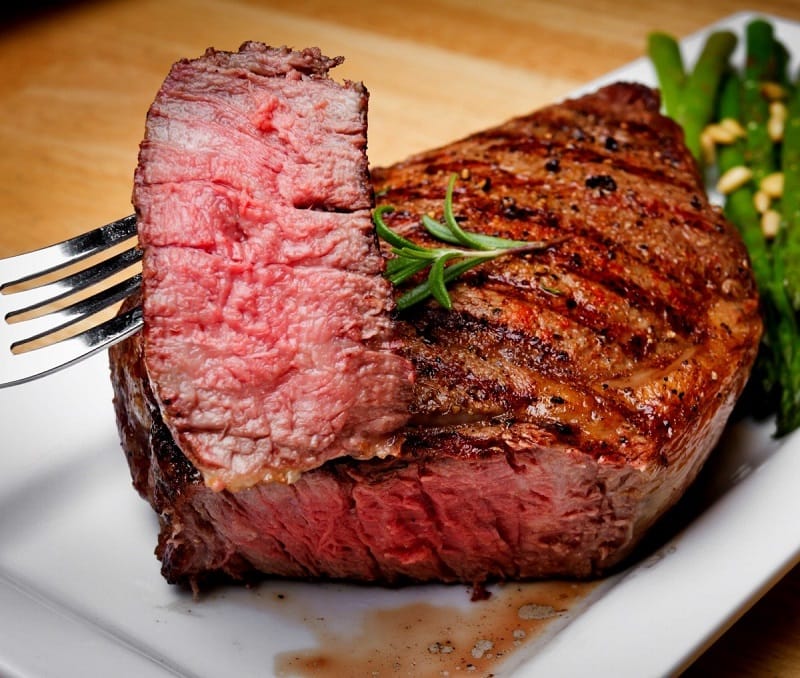
Eating steak has long been a favorite for many, and for a good reason. Not only does it taste delicious, but it also provides a number of health benefits. From providing essential proteins and minerals to aiding digestion, steak can certainly benefit our health.
- Firstly, steak is an excellent source of essential proteins, minerals, and vitamins necessary for the proper functioning of the body. Protein is essential for developing and repairing body tissues, while minerals and vitamins help support the immune system, aid digestion, and provide energy. Eating steak can provide you with all of these essential nutrients, helping ensure you get the necessary amounts for optimal health.
- In addition to providing essential nutrients, steak also contains a range of other important compounds that can benefit our health. These include conjugated linoleic acid (CLA), which has been found to have potential benefits for weight loss, and the antioxidant selenium, which helps protect cells from damage.
- Moreover, the fat content in steak is another important benefit. While it is true that steak contains a higher fat content than other types of meat, it is important to understand that not all fat is bad. In fact, certain types of fat, such as monounsaturated and polyunsaturated fats, are beneficial for our health and can help to reduce cholesterol levels and improve cardiovascular health.
- Finally, steak can also be beneficial for aiding digestion. It is high in fiber, which helps the digestive system to break down food more easily and aids in the absorption of nutrients. In addition, it also contains a range of amino acids that can help to reduce inflammation and improve gut health.
All in all, steak is a great option for those looking to get the most out of their diet in terms of health benefits. From providing essential proteins and minerals to aiding digestion, steak can certainly benefit our health.
Can You Identify A Good Quality Steak Just By Looking At It?
There are some signs of a good quality steak that you can use to help you pick out the best steak when you’re out shopping. Here are some tips to help you identify a good quality steak just by looking at it:
Look For A Thick Cut
When it comes to steak, thicker cuts are generally better. Thin cuts are more likely to be tough and lack flavor. Look for steaks that are at least one inch thick. This will ensure that you get a juicy, flavorful steak.
Look For An Even Color
Look for a steak that has an even color. You should be able to see a uniform color throughout the steak. If there are any dark spots, it means the steak has been overcooked.
Look For Marbling
When you look at the steak, you should be able to see some marbling. Marbling is the thin strands of fat that run throughout the steak. This fat adds flavor and juiciness.
Look For A Glossy Finish
A good quality steak should have a glossy finish. This is a sign of freshness. The steak may not be of the best quality if it looks dry or dull.
Smell It
Yes, you can smell your steak. Quality steaks should have a pleasant smell. It may not be the best quality steak if it smells sour or off.
Which Countries Produce Steaks?
When it comes to steaks, some countries stand out as being the best producers of this delicious food. Whether it’s rib-eye, sirloin, or filet mignon, there are certain countries that have the best steak. From the United States to Japan, these countries have the best cuts of steak.
- The United States is home to some of the best steaks in the world – and it is no surprise. From the Midwest to the East Coast, the US is home to a variety of different steak cuts. The US has a wide range of high-quality steaks, from the famed rib-eye to the lesser-known flat-iron steak. What’s more, American steaks are often served with various condiments, from traditional ketchup to A1 steak sauce.
- Australia is another country known for its steak. With its roots in the outback, this country is renowned for its steak cuts. There’s something for everyone, from the much-loved rump steak to the lesser-known scotch fillet. What’s more, many Australians enjoy barbequed steak, which is often cooked over an open flame.
- Brazil is also home to some of the best steaks in the world. With its grass-fed beef and large variety of cuts, it’s no wonder Brazil is a great place to get steak. From the famous picanha to the lesser-known maminha, Brazilian steaks are some of the most flavorful in the world.
- Japan is another country that produces some of the best steaks in the world. Known for its wagyu beef, Japan is home to some of the most sought-after steak cuts. From the classic sirloin to the lesser-known teppanyaki, Japanese steaks are sure to satisfy the most discerning palate.
- Finally, Argentina is another great place to find steak. This country is known for its grass-fed beef, often cooked over an open flame. From the classic beef skirt steak to the lesser-known vacio, Argentine steaks are some of the most flavorful in the world.
How to Cook the Perfect Steak?
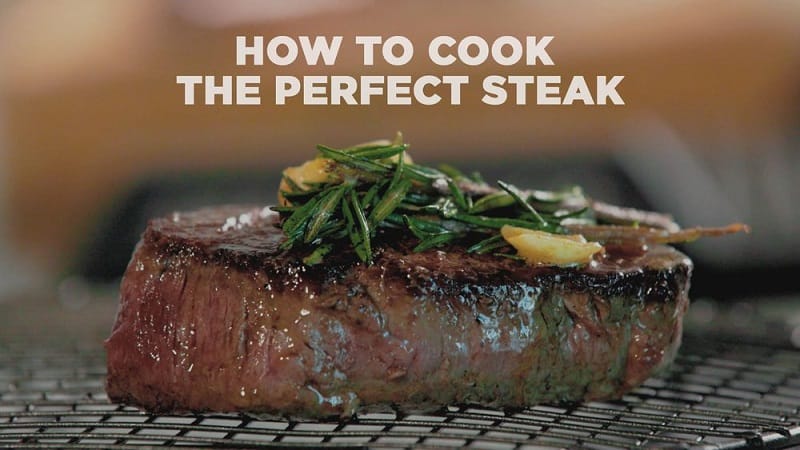
Are you looking to cook the perfect steak? Whether you’re cooking a ribeye, New York strip, or top sirloin, there’s nothing quite like a perfectly cooked steak. Follow these steps to ensure your steak turns out juicy, tender, and perfectly cooked.
- First, remove your steaks from the refrigerator and let them sit at room temperature for at least 30 minutes. This helps the steak reach an even temperature throughout and helps ensure a perfect cook. Once the steaks have reached room temperature, coat them in olive oil and rub both sides with salt, pepper, and white pepper.
- Next, heat a skillet on the stovetop over high heat and place the steaks in the pan. Sear the steaks for 2-3 minutes per side, including any fat on the steak. Once the steaks are seared, you can finish cooking them in the oven. Preheat the oven to 375 degrees and slide the skillet in with the steaks. For medium rare, cook the steaks for about 8-10 minutes and remove them from the oven when the internal temperature reaches 130 degrees.
- While the steaks are cooking, you can prepare the butter mixture. Combine 1 tablespoon of butter with a clove of minced garlic in a small bowl and set aside.
- Once the steaks are finished cooking, remove them from the oven and top each one with a tablespoon of the butter mixture. Let the steaks rest for 10 minutes before cutting into them.
- While the steaks are cooking, you can prepare the butter mixture. Combine 1 tablespoon of butter with a clove of minced garlic in a small bowl and set aside.
- Once the steaks are finished cooking, remove them from the oven and top each one with a tablespoon of the butter mixture. Let the steaks rest for 10 minutes before cutting into them.
Are There Any Health Concerns Related To Eating Red Meat?
Are you a meat lover? If so, you may wonder if any health concerns are associated with eating red meat. After all, red meat has been linked to a variety of health issues, including an increased risk of heart disease, stroke, and certain types of cancer.
The short answer is yes, health concerns are associated with eating red meat. However, the degree to which these risks are present depends on several factors, including the type and amount of red meat consumed.
When it comes to red meat, it’s important to understand the difference between “lean” cuts, such as sirloin, and “fatty” cuts, such as rib-eye. The lean cuts contain less fat and cholesterol, making them healthier. However, fatty cuts still contain some fat, and consuming too much of these types of red meat can increase your risk of heart disease and stroke.
Research has also linked higher consumption of processed red meat, such as bacon, hot dogs, and cold cuts, to an increased risk of certain types of cancer. This is because processed meats have been linked to higher levels of carcinogenic compounds.
When it comes to red meat, it’s important to keep your portion sizes moderate. The Dietary Guidelines for Americans recommends limiting red meat intake to no more than 10-12 ounces per week. If you choose to consume red meat, opt for leaner cuts and limit your consumption of processed red meats.
It’s also important to note that other health concerns are associated with red meat consumption. For example, red meat consumption has been associated with increased levels of inflammation and a higher risk of diabetes.
Overall, while red meat consumption can be part of a healthy diet, it’s important to remember that it can also increase your risk of certain health problems. Eating leaner cuts of red meat in moderation and limiting your consumption of processed red meats can help reduce these risks.
FAQs About Where Does Steak Come From
What Are Some Common Marinades For Steak?
Common marinades for steak include balsamic, red wine, Italian, fajita, garlic and herb, ginger soy, and lemon pepper. These marinades are made up of a variety of ingredients, such as olive oil, balsamic vinegar, red wine vinegar, soy sauce, lemon juice, Worcestershire sauce, minced garlic, and other herbs and spices.
Acidic ingredients like lemon juice, lime juice, red wine, and vinegar help break down the steak’s fibers and allow the flavor to penetrate the meat. Dairy products like yogurt can also be used as a marinade ingredient.
With these common marinades for steak, you can easily create delicious and flavorful dishes with your favorite cuts of steak.
Is There An Optimal Temperature For Cooking A Great-Tasting And Juicy Steak?
Cooking a great-tasting, juicy steak is about getting the temperature right. The USDA recommends that all beef be cooked to an internal temperature of 165 degrees Fahrenheit for safe consumption, but most steak lovers prefer a perfect medium-rare steak cooked to 130-135 °F.
To get the meat’s natural flavor, cook a medium-rare steak to medium-rare by preheating an outdoor grill to high heat (about 450-500°F) and searing each side for 3 minutes. If a meat thermometer is available, aim for an internal temperature of 52°C/125°F.
For added flavor, add butter or herbs to the pan and use a spoon to baste the juices while cooking. The result will be a warm red center with a nice brown crust and a perfect steak texture.
How Much Does A Side Of Beef Typically Cost?
A side of beef typically costs anywhere from $1,200 – $1,800, depending on the quantity of meat purchased, the butcher shop you purchase from, geographical location, and quality of meat. On average, a side of beef will cost around $7.00 – $8.00 per pound. For those looking for a more significant purchase, quarter beef is available at a slightly higher price of $6.25 per pound. A whole beef will cost the most, running between $8.48 – $15.62 per pound.
It’s important to remember that these prices are based on an animal’s average size and build; the cost may vary slightly if it’s bigger or smaller than usual.
Why Should Meat Be Allowed To Rest Before Serving?
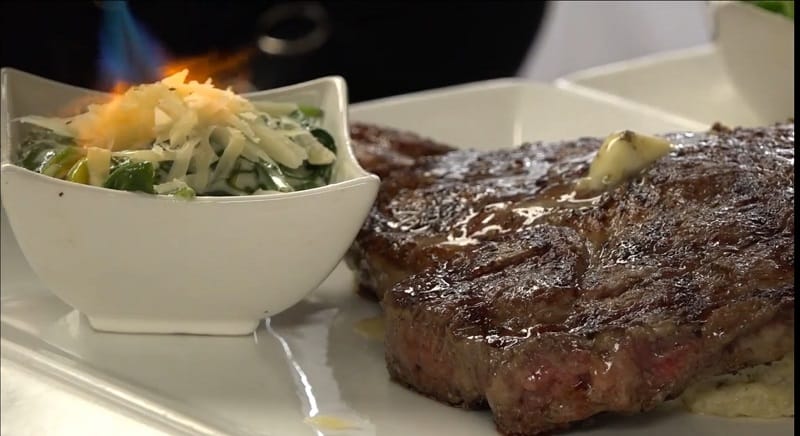
Allowing the meat to rest after cooking and before cutting lets, the juices be reabsorbed into the fibers of the meat, ensuring it is tender and juicy when served. As a rule of thumb, thinner cuts should rest for 5-7 minutes, while thicker cuts should rest for 10-20 minutes. This process makes the meat much juicier and tastier, so it’s worth the wait.
Not allowing your steak to rest could result in a less-than-optimal, juicy, flavorful steak. So allow your steak to rest to get the most out of your meal!
Is There A Difference In Climate Footprint Between Different Types Of Meat?
It is well established that different types of meat have varying climate footprints. Red meat and dairy typically have a much higher footprint than plant-based foods, as their emissions are mainly methane.
On average, the emissions of plant-based foods are 10 to 50 times lower than those of red meats. This is due to the fact that the carbon footprint of red meats is much higher than that of plants, as one kilogram of beef results in 60 kilograms of greenhouse gas emissions, nearly 2.5 times the closest food type – lamb and mutton.
Furthermore, research has found that animal products are responsible for more than half of food-related greenhouse gas emissions, despite only representing 15% of calories consumed globally. Wild seafood has a considerably lower carbon footprint than red meats, while beef has the highest carbon footprint among all meats – one that’s 50% higher than beef. Therefore, it is clear that there are significant differences in climate footprints between different types of meat.
Are There Any Other Animal Proteins That Can Be Cooked Like Steak?
Yes, other animal proteins can be cooked like a steak.
- Bison is a great example. It is lower in fat than beef and typically has 25 percent fewer calories. It also contains more protein than beef and is leaner than other red meats.
- Pork is another leaner option, with loin cuts such as tenderloin or top loin typically being the leanest.
- Ground beef is a more commonly known alternative to steak, containing 27g of protein in every 3.5oz. Ground beef might be better than red meat for those who need to reduce their saturated fat intake.
- Lastly, chicken and fish are lean protein sources that can be cooked similarly to steak.
What Types Of Tools Should I Have In My Kitchen For Cooking Steaks?
Having the right tools in your kitchen is essential for cooking a perfect steak.
- A cast iron skillet is a classic choice for steak lovers as it retains heat well.
- To ensure you don’t overcook or undercook your steak, you should also invest in a good quality digital meat thermometer.
- The Ultimate Steak Knife Set from Williams-Sonoma is ideal for cutting through a juicy steak.
- You’ll also need a good grill to get that perfect char on the outside while keeping the inside tender and juicy.
- Lastly, a Marvel Mighty Thor Mjolnir Hammer Replica Stainless Steel Meat Tenderizer Pounder Gourmet Mallet Masher Tool will help you to tenderize and season your steak perfectly.
With these tools in your kitchen, you’ll be ready to cook up some delicious steaks like a pro in no time!
Conclusion
So there you have it: steak comes from cattle, is made up of fat marbling, and can be cooked in various ways. So if you’re a steak lover, now you know the answer: where does steak come from? Bon appétit!
And that’s all there is to it! Now you know where does steak come from. With this information in hand, you’re ready to tackle dinner tonight.
References:
- https://vocal.media/feast/essential-tools-for-cooking-steak
- https://www.webstaurantstore.com/blog/2962/letting-meat-rest.html
- https://www.gimmesomeoven.com/5-easy-steak-marinades/

Hey readers! Chip Holland here, and I’m a Manager of this website. My passion for writing about it only matches my passion for BBQ. Follow my blog for mouth-watering recipes, tips, and tricks for the perfect smoke, grill, and BBQ. I’m sure you won’t be disappointed!
